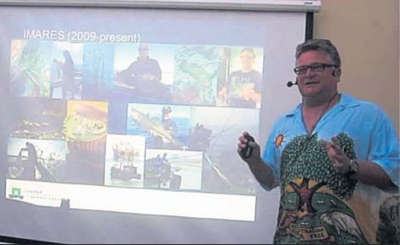The Daily Herald writes about the Sea & learn evening of last Saturday. Saba Banks, the 4th largest atoll in the world, a cradle of marine biodiversity and a bellwether for Caribbean ecosystems, was at the heart of this year’s Sea and Learn lectures. Wageningen University fisheries management expert Dr. Martin de Graaf talked about “Saba Bank Management” during an evening event hosted at Lambee’s Place courtyard in Windwardside on Saturday, October 19.
A research scientist for Institute of Marine Resources and Ecosystem Studies (IMARES) in the Netherlands, Dr. De Graaf is the project leader for fisheries research on Saba, St. Eustatius and Bonaire, while overseeing the Dutch national research programme for recreational fisheries. He is a consultant with the Ministry of Economic Affairs for the Saba Banks fish populations monitoring and management programme. The ministry has international obligation to report catch data and developments in fish stocks. Data collection, needed for both exploitation and conservation efforts, is still limited due to management capacity. De Graaf’s work is to set up “quantifiable” objectives for fisheries to determine performance. He favours dependent and independent surveys of fish fluctuations over months and years, stressing that results shouldn’t trigger precipitous conclusions.
The National Park status of Saba Banks, with its designation as a Particularly Sensitive Sea Area, led to a ban on anchoring since December 2010. Saban fishery involves only 9 small fishing boats monitored in Fort Bay harbour through voluntary interviews and onboard sampling. Participants questioned De Graaf on who determines the size of the nets used by fishermen, leading to the answer about regulations being extensive, but local enforcement lacking. De Graaf defended the surveyors’ mandate as restricted to volunteered information. Fishermen’s catch, he said, is being legally protected as private business information. He acknowledged a data-backed significant drop in the size of lobsters correlated with a substantial increase in the number of lobster traps. The significant drop from almost 100 tons in 2007 to fewer than 40 in 2012 is comparable with the regional trend. He spoke on the difficulty of setting up minimal harvesting sizes for lobster maturity. Fortunately, the study findings show correlation between volunteered information and catch measured independently. Local fishermen’s honesty is commendable, as they are major stakeholders in the sustainability of the fishery. Anecdotal accounts of fishermen’s increasing burden to secure comparable income are now reflected in statistical data. De Graaf mentioned a fishermen’s self-imposed ban on the redfish trap fishery in 2000 and its reopening three months ago with no government involvement.
Since last year, a Saba Banks Stereo Baited Remote Underwater Video (sBRUV) system has been installed, providing a permanent record of predators and limiting the observer bias. A conch abundance and location research has also been conducted, leading to a video mapping of the marine habitats around St. Eustatius, and this is currently being implemented around Saba. The latter conch research was triggered by the ban on Statia conch export to independent St. Maarten without a CITES permit. The data collection for establishing a sustainable quota and the permit-issuing process may take six months to a year. Asked if in the meantime the ban is enforced by the St. Eustatius government, De Graaf suggested that the local fishery is tolerated for personal consumption, but technically illegal.
De Graaf also talked about using logged data provided by SeaSaba dive business operators on some 2,000 dives and approximately 1,000 shark sightings to predict likely sightings at precise times and locations.
Questioned about the monitoring of the invasive Lionfish and on Dutch national funding required for research, De Graaf explained it is a political struggle to obtain specific Caribbean funding. A basic short-term budget exists under the national fisheries programme. Asked for clarity of national versus local government responsibilities on Saba Banks, he explained that one third of it falls under the 12 mile Economic Exclusive zone managed by the local government and between 12 and 200 miles under the central government, but one set of rules is sought for both zones.

 Archive of posts from Saba-News.com Archive Saba News
Archive of posts from Saba-News.com Archive Saba News